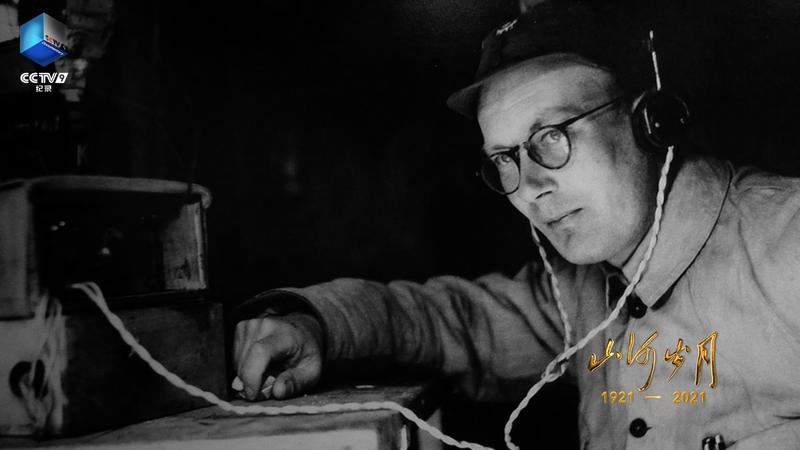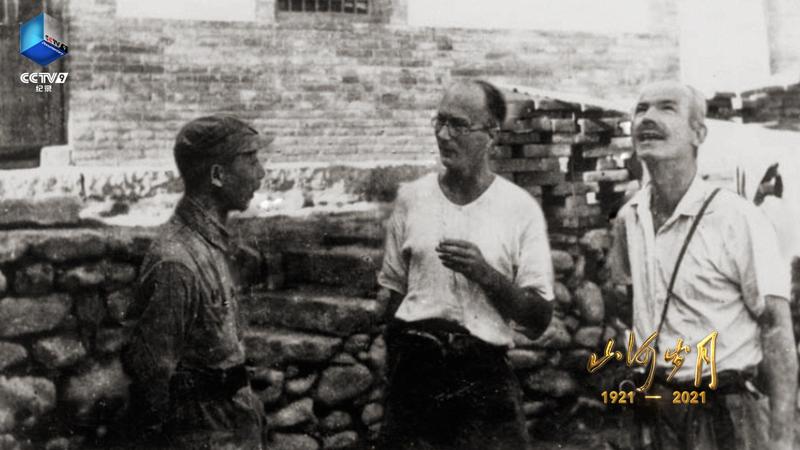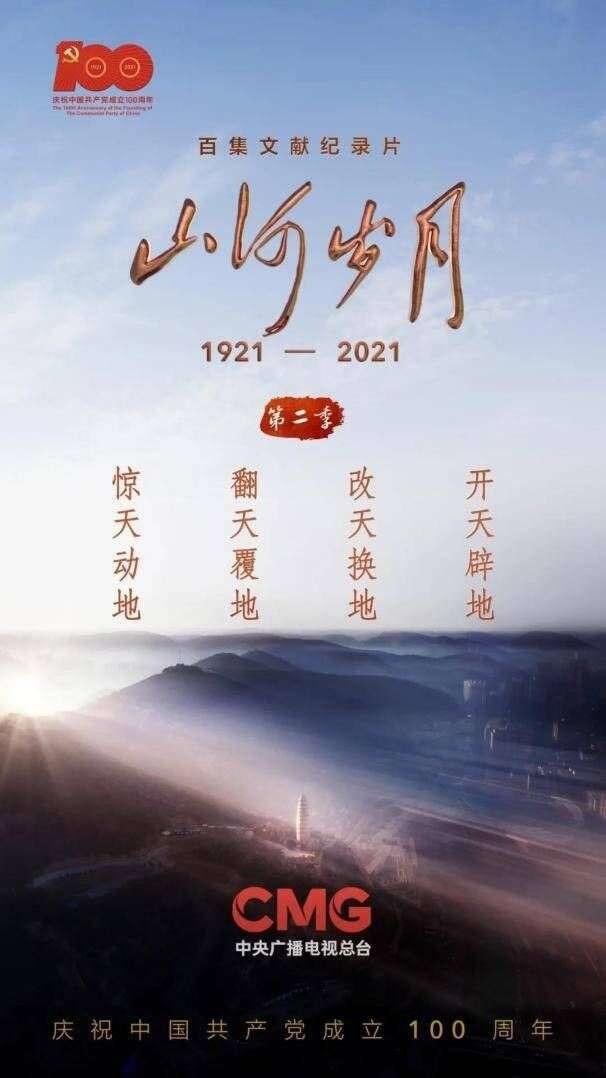Documentary series focuses on key figures, both foreign and domestic, to tell the story of wartime China and how victory was won, Wang Kaihao reports.
 Students arrive in Yan'an, Shaanxi province, to join the revolution led by the Communist Party of China. (PHOTO PROVIDED TO CHINA DAILY)
Students arrive in Yan'an, Shaanxi province, to join the revolution led by the Communist Party of China. (PHOTO PROVIDED TO CHINA DAILY)
In 1936, Shafick George Hatem, an American doctor who was based in Shanghai, accepted an invitation to visit Yan'an in the north of Shaanxi province which, at the time, was a major revolutionary base for the Communist Party of China. Setting off on the trip, it's perhaps safe to presume that he did not expect the visit to utterly change his life.
However, that supposedly short visit turned into a lifetime commitment. Witnessing the Party's endeavor to rescue the country, which was on the edge of being torn apart by Japanese invasion and social turmoil, Hatem decided to stay in Yan'an to lastingly support the War of Resistance Against Japanese Aggression (1931-45) and the Chinese revolution.
These foreign friends joined Chinese people’s struggle for liberation during the toughest time of the war. They won the respect of the Chinese people, indefinitely
Xia Meng, director of the documentary Shanhe Suiyue
For Chinese people, he is better known as Ma Haide, later becoming one of the first foreigners granted Chinese citizenship after the founding of New China in 1949, through which he would go on to make a great contribution to the country's public health system.
In those tough years, a long list of foreigners made significant contributions to the Chinese revolution, including Ma, Michael Lindsay, the British scholar from Yenching University and Canadian doctor Henry Norman Bethune, among others.
These heroic figures of wartime China are being honored in a TV documentary series celebrating the 100th anniversary of the founding of the Communist Party of China.
The 100-episode documentary produced by China Media Group, Shanhe Suiyue, which can be translated as "the country and the years", serves as a reminder of the sacrifices and struggles of the Chinese people on the revolutionary path to glory. The second season of the program ran from Aug 15 to Wednesday, and the War of Resistance Against Japanese Aggression formed a major part of it.
"It's a period of time that decided the destiny of China," says Xia Meng, director of the documentary who is also a member of the 13th National Committee of the Chinese People's Political Consultative Conference.
 British scholar Michael Lindsay helps the CPC to run a radio station during the War of Resistance Against Japanese Aggression (1931-45). (PHOTO PROVIDED TO CHINA DAILY)
British scholar Michael Lindsay helps the CPC to run a radio station during the War of Resistance Against Japanese Aggression (1931-45). (PHOTO PROVIDED TO CHINA DAILY)
According to Xia, Shanhe Suiyue, with a total length of more than 41 hours, is the largest documentary production on the Chinese revolution.
He says it was essential to include the stories of these foreign legends for this key production celebrating the centennial of the founding of the CPC.
"These foreign friends joined Chinese people's struggle for liberation during the toughest time of the war," Xia tells China Daily. "They won the respect of the Chinese people, indefinitely."
For example, Lindsay managed to run away from Yenching University in Beijing, which was, at the time, run by American and British churches following the start of the Pacific War in 1941. He went to the Shanxi-Chahar-Hebei revolutionary base area and supported the Party, running a radio station during the war in spite of the poor facilities available. Chahar was then a province in northern China.
Bethune is even more of a household name in China. The Canadian doctor spared no effort attempting to cure Chinese soldiers, once completing a staggering 115 operations in 69 hours, before finally dying on the front line. Chairman Mao Zedong once said about him: "His utter devotion to others without any thought of self was shown in his great sense of responsibility in his work and his warmheartedness toward all comrades and the people."
 (From left) Chinese general Nie Rongzhen, Lindsay and Henry Norman Bethune stationed in the Shanxi-Chahar-Hebei revolutionary base area. (PHOTO PROVIDED TO CHINA DAILY)
(From left) Chinese general Nie Rongzhen, Lindsay and Henry Norman Bethune stationed in the Shanxi-Chahar-Hebei revolutionary base area. (PHOTO PROVIDED TO CHINA DAILY)
New narrative angles are also explored in the documentary. From the perspective of Evans Carlson, a US Marine Corps general officer, and Joseph Stilwell, a US Army general, the bravery and exceptional contribution of the CPC-led Eighth Route Army in the war is highlighted. Their positive remarks also helped former US president Franklin Roosevelt to have a relatively objective view of the CPC, Xia says.
"From their viewpoint as a third party on the War of Resistance Against Japanese Aggression and CPC-led anti-Japanese base, we can better understand the real opinions of US diplomats and military personnel toward the Party at that time," Xia says. "It can also benefit diplomatic work today."
A picture of an unyielding nation was unrolled before these foreign eyes. In the second season of Shanhe Suiyue, the strong spirit of Chinese revolutionaries are reflected not only through their bravery on the battlefields across the nation, but also through their morale in pursuing economic development and expectation for a bright future.
For this production, it was not an easy task to search for the necessary historical references among the hoards of files and documents available, let alone the tight schedule and the fact there was no room for the slightest error.
"This production is like a document, and thus is highly demanding in its authenticity," Xia says. "Watching this kind of rigidly produced documentary, people often treat it as a record of history. If we mistakenly use one file or picture, people will doubt its credibility.
"But we also need to pursue artistic aesthetics," he continues. "So when we tell stories in this documentary, the focus is not put on the 'stories', per se, but the people. With these people, history will become relatable."
 A poster of the documentary Shanhe Suiyue. (PHOTO PROVIDED TO CHINA DAILY)
A poster of the documentary Shanhe Suiyue. (PHOTO PROVIDED TO CHINA DAILY)
Xia says a major challenge in making this production was that firsthand film footage of the Party during wartime is scarce.
"In the 1930s, the Party stuck to fighting in the countryside and thus lacked the facilities to film any historical footage," he says. "When portraying this period of history in documentaries, some directors tend to use the approach of a docudrama to fill the gap, but flaws in the acting may sometimes cause audiences to detach from the history."
Consequently, some clips of classic films and TV series along the same historic themes are borrowed for the documentary, in order to make the production more approachable for the audience.
The director says the vividly told stories will also better explain political theories and academic issues surrounding revolutionary history to the general public through plain words.
During the production of the documentary, Xia says the research also helped uncover new details in the Party's history.
"When people's stories overlap with each other, all elements of a grand picture of history will be portrayed," Xia says. "We're touched by those historical figures when we read Shiji (a foundational text of Chinese history from the 2nd century BC), and the 100-year history of the CPC is also a record of the continuous effort of generations of people."
"Shanhe Suiyue ushers the Party and Chinese people to inherit the revolutionary tradition and bravery of the revolutionaries," says Wang Yongli, a producer with China Central Television. "People will thus be encouraged to make progress for the great rejuvenation of the Chinese nation."
Yan Wei, a critic with Chinese Television Art Committee, says: "Standing in the new era, this documentary emotionally reviews the footsteps of the CPC with a rational and philosophical mind."
Contact the writer at wangkaihao@chinadaily.com.cn


